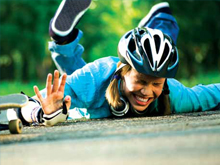Health Topics
-
Healthy Living
-
|
|
October 2010
|
| Sports Injuries in Young Athletes |
| Dr. Sharat Kumar |
| |
 |
Injuries can mar a child’s sporting future. Young athletes are not miniature adults, which means that their muscles, tendons, bones and ligaments are still growing - making them susceptible to injury. The adolescent growth spurt predisposes children to injury, particularly at their growth plate, which determines the length and shape of the mature bones. |
Types of Injuries
The majority of sports injuries are relatively minor, like bruises, sprains and strains, which can occur during contact and non-contact sports or while training. Significant injuries like growth plate injury, fracture, dislocation, head injury and spinal injury can sometimes cause permanent disability - and every effort should be taken to prevent and minimise them.
Macrotrauma or acute injuries are the result of a single application of force, which brings about tissue damage. Microtrauma or injuries due repetitive stress is what comprises 40 percent of all sports injuries. It leads to inflammation of the muscle tendons and stress fractures. Common overuse injuries are tennis elbow (remember Sachin Tendulkar’s?), anterior knee pain, little league elbow, shin splints and plantar fasciitis (the painfull inflammatory process in the thick connective tissue which supports the arch of the foot).
Sticking to rules of the game and training appropriately are important, not only for performance, but also for injury prevention. Sports specific equipment is essential to avoid and minimise injuries.
Taking Care of Your Injuries
If not anything in this article, just remember this acrostic ‘P R I C E S’
- Protection of the injured part
- Rest
- Ice to control bleeding, pain and oedema
- Compression to control swelling, and for support
- Elevation to decrease oedema and bleeding
- Support for stabilising injured part
5 Good Wound Care
- Wash hands thoroughly
- Avoid touching the wounds with hands while treating
- Don’t talk, cough or breathe over the wound or dressing
- Cover the wound with a sterilised dressing
- Raise and support the injured part to prevent swelling
Are there different types of pneumonia?
When you catch such infections, primarily from being in public places (except a hospital), it is called community-acquired pneumonia. Hospital-acquired pneumonia on the other hand, is acquired during or after hospitalisation for another illness or procedure. You get it within 72 hrs of admission – so be careful of the kind of hospital you get into.
Do I need to see the doctor soon?
While there are many microbes that can cause bacterial pneumonia, the most frequent culprit is a bug called streptococcus pneumonia. It’s important to understand that symptoms of pneumonia need immediate medical evaluation. Physical examination by a doctor may prevent life-threatening spread of the infection from lung to rest of body through bloodstream, a condition called sepsis.
What would my doctor do?
Typically he would ask for chest x-rays, blood test, examination of the cough, and sometimes chest CT (computed tomography). Most cases of pneumonia can be treated without hospitalisation with oral antibiotics, rest and fluids. However for those with serious symptoms, other medical problems, and for the elderly, he would ask them to be hospitalised for intravenous antibiotics and other supportive measures like oxygen, intravenous fluids and sometimes in serious cases, ventilation.
Could I have prevented this?
Not always, but do get treatment for underlying illnesses (such as AIDS). Stop smoking, if you do. Children and the elderly could use with vaccinations against certain bacteria.
|
7 Tips for Injury Prevention
- Proper nutrition and body conditioning
- Maintain healthy weight
- Wear protective equipment
- Do not play if in pain or sick
- Learn and play within the rules of the game
- Warm up and cool down
- Drink plenty of water
|
|
| Dr. Sharat Kumar is Sports Medicine Consultant, Joint and Arthroscopic surgeon at Apollo Health City Hyderabad |
|
|